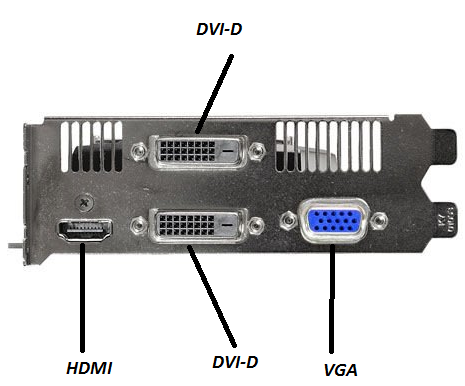How to Setup Dual Monitors
Windows 7, 8 and 10
In need of extra screen space? Having two monitors or multiple monitors can increase productivity by expanding the amount of on-screen space. In this guide, we will walk you through all the required steps to get you started with your dual monitor setup.
First, let’s take a look at what is required in order to achieve a dual-monitor setup. A setup of this kind won’t be possible if your computer doesn’t support multiple video connections. At a minimum, you’ll need two video-out ports to connect both of your monitors. Generally, there are four types of ports: VGA, DVI, HDMI, and DisplayPort.

Note: If you do not have the required ports, then you will need an external connector/adapter to connect the monitors to the system.
Most systems, both laptops and desktops, nowadays are capable of accommodating a dual-monitor setup. However, there may be compatibility or support issues depending on your specs, so be sure to check the manual for the availability of ports. Generally, desktops have more ports capable of outputting to multiple external monitors. However, even with laptops, most of them have either two HDMI ports or a combination of HDMI and DVI.
Continue with the next section to make sure your equipment checks out.
Gathering the hardware.
The best way to set up your dual-monitor setup is highly dependent on how your monitors connect and the ports on your laptop/desktop. It’s very important that you take your computer ports into account before you buy a second monitor. This will save you from having to spend extra money on an additional adapter.

Begin by inspecting your computer’s video ports to determine what you are working with. Check if you can set up the connection without an adapter. However, you might not have a choice.
For example, if you want the second screen to be your old VGA monitor, you will likely need an adapter like this one in order to connect it to the HDMI port of a new laptop. Likewise, if you have an old DVI monitor, you will need an adapter of this kind to plug it into an HDMI port.
Most laptops come with multiple video ports. Let’s take the popular Dell Latitude E6230 as an example. It contains one 19-pin HDMI connector and one VGA connector. Considering these options, one monitor can be connected to the HDMI port, and the other one can be connected to the VGA port.
Desktops, on the other hand, have a built-in VGA on the motherboard and multiple HDMI and DVI ports on the dedicated graphics card. This is why desktops are ideal for dual monitor setups.
In case you have only one port (VGA, HDMI, or DVI), you will need a dual adapter. If the port is VGA, you’ll need a monitor VGA dual splitter. If your port is DVI and both of your monitors are VGA, you’ll need a DVI-I Analog to 2x VGA Video Splitter Cable. However, keep in mind that this setup is not ideal, as it will only duplicate the display and won’t work with the Extend mode.
Note: Usually, the motherboard’s built-in VGA ports are not powerful enough to support two monitors, so you can expect some blurred pixels.
Once you have both your monitors, make sure that your ports check out, and obtain the required adapters (if necessary), it’s time to configure it all under Windows.
Connecting the Equipment
If you were prepared for a lengthy tutorial, you can rest easy. Windows makes connecting multiple monitors extremely easy. And for the most part, this is true for all recent Windows versions.
All you have to do is plug the second monitor into the appropriate port (via an adapter if required), and Windows should automatically extend your desktop onto it. That’s it.
However, depending on your settings, Windows might mirror your second display instead, showing the same thing on both screens. In this case, you’ll need to make additional adjustments.
Configuring the Settings.
Windows 8 and Windows 10:
If you are seeing a mirrored display on both monitors, you will want to press the Windows key + P and choose the Extend option. This will provide an entire monitor’s worth of additional screen space.

If you want to take the long route, you can also right-click anywhere on your desktop and select Display Settings. From there, click the Identify (Detect) button, then drag and drop both displays until you position them however you want.

Note: Keep in mind that number 1 is always the primary display.
Windows 7:
The Windows key + P shortcut can also be used on Windows 7. If your display is mirrored by default, use the shortcut to select the Extend mode.

Alternatively, you can do it by right-clicking on the desktop and selecting ‘Screen Resolution.’ Once there, click the ‘Identify‘ button if the second monitor doesn’t already appear, and then position them however you want.
 Once the monitors are connected, you will need to adjust the settings. This can be easily done from the Display Settings on your computer (Windows Vista, 7, and 8) by right-clicking on your desktop and selecting Personalize -> Display -> Change Display Settings.
Once the monitors are connected, you will need to adjust the settings. This can be easily done from the Display Settings on your computer (Windows Vista, 7, and 8) by right-clicking on your desktop and selecting Personalize -> Display -> Change Display Settings.
Note: The Extend mode will not work if the monitors receive the same signal. You will need signals coming from two ports if you wish to utilize the extended feature.